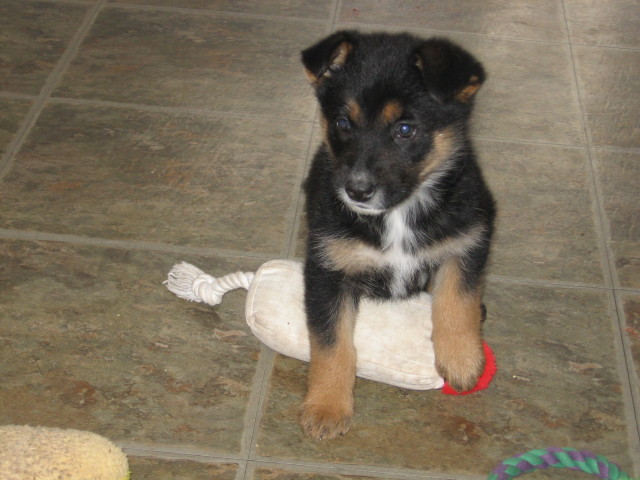QuestionWe are currently fostering a 2 year old deaf white boxer bitch for a Boxer Rescue in the UK.
She suffers SA when left alone, even with another dog in the home with her. We are lucky in that she is not destructive but she cries and barks which is not great. I am currently taking her to work with me but this will cause awful problems in rehoming her. We have tried crating her by getting her used to one bit by bit but once left in it, she harms her mouth and paws trying to get out.
I was wondering if you could give me some advice to help rehabilitate this girl so that we can find her a loving new forever home?
Many thanks
Louise
AnswerDeafness can be by degree: perhaps this dog can hear her own voice, and this behavior is self rewarding. I do not suggest a crate; this is not a humane device in my opinion and should be selected voluntarily by any dog (with the door open); dogs should only be confined to the crate for short periods during house training (such as, at night, no more than 8 hours for a young adult dog; puppies need to be taken out throughout the night, no matter the inconvenience to the human.) Taking her to work with you is not a good idea, since she is over bonding to you and this will worsen the Separation Anxiety in the next home.
Regardless of her being deaf, she can be desensitized to being left alone. This can be done in short intervals (at first), even as short as five minutes. The first thing is to follow your own pattern of behavior when preparing to leave; everyone has one, but we're not conscious of it. Whatever yours is, change it every day, so as not to give this dog a cue that will set her up for anxiety. She has already suffered the enormous emotional loss of her first "family" and it is predictable for her to fear leave taking. How you live with her on a daily basis and how you desensitize her to leave taking can make a huge difference.
Deaf dogs (as any hearing impaired living thing) compensate for their disability by responding with heightened sensitivity to other senses. This dog has been deaf from birth;if she is profoundly deaf and cannot hear her own voice, someone, somewhere responded to her barking and whining and actually (inadvertently) trained it. Dogs observe us quite closely (and any living thing in their environment with whom they establish a conspecific relationship). A deaf dog will have developed this skill to a fault. Therefor, your visual cues (including the look on your face, your body posture and other mannerisms) communicate instantly to this dog. Alter your leave taking behaviors (put your coat on five minutes before you leave, pick up your keys ten seconds later, leave your shoes outside, etc., and vary it daily); put on a "happy face" for several minutes before leaving and be sure you maintain it so as not to cue her that you are anxious because you are about to leave. If you have a baby monitor, put the sending station in the room with the dog and if possible hook up the receiving station in an adjoining place (like the garage); leave the house and listen. See how long it takes her before she begins to bark. This may take quite a while, in which case you would reenter the home BEFORE she starts; if it's immediate, you must not reenter until she stops. Because she is deaf, you can't interrupt her barking with a sudden (benign) sound (such as a bell), but you can use a visual signal. Shine a flashlight into the room through the window, in pulses; this will startle her (not frighten her, just get her attention) and she will stop barking long enough for you to go back indoors. Whenever coming back in, give a minute or two before you greet her and keep it short but sweet. Repeat this leavetaking several times over the course of a week.
Meanwhile, obtain an object (something you don't want seen around, like a rubber rat, an ugly statue, etc.) When planning to be at home, take out the object and give the dog a clear signal for "time out" (the actual "T" would do) then ACTIVELY IGNORE HER as if she is not there for thirty minutes. At the end of the time period, remove the object and greet the dog; interact with her with a toy for a few minutes, then go back to normal. This "time out" object should be conditioned within a few trials and she will begin to recognize it as a signal that you are unavailable. Once you SEE HER respond TO THE OBJECT by removing herself (going to lie down) or displacing her attention in any way (turning her head, turning her body, etc.) you will be able to use it when you leave the house. You place the time out object in plain sight of the dog (with the visual cue) and then leave. DO NOT say "goodbye" to the dog, this is charging her emotionally. There's nothing wrong with just walking out, it won't hurt her feelings.
Slowly getting her accustomed to leavetakings and creating a conditioned object so she anticipates your unavailability is a combination that works to lessen the dog's anxiety and assist the dog in obtaining independent behaviors. Separation anxiety often self extinguishes once the dog begins to feel secure. I've had multiple rescue dogs in my home over the years, and never once did I see a case of separation anxiety. There was strong, loving, consistent and fair leadership; the dog(s) did not feel anxious because they were clearly never in charge. The deaf dog, because it watches us SO closely, is a huge candidate for positive reinforcement training using hand signals both as an indicator of reward and a cue for behavior. Here's one place to start learning how to do it:
http://www.deafdogs.org/training/

 my 7 month old golden changed for the worse
QuestionRiley at 6 months
QUESTION: I got a gold
my 7 month old golden changed for the worse
QuestionRiley at 6 months
QUESTION: I got a gold
 Psychological trauma
Question
Izzy
I recently took my 1 year old dog to a fr
Psychological trauma
Question
Izzy
I recently took my 1 year old dog to a fr
 puppy problems
QuestionQUESTION: I am the proud owner of 2 german shep
puppy problems
QuestionQUESTION: I am the proud owner of 2 german shep
 Dog in Heat?
QuestionLily and Jorge
QUESTION: Hello,
We have
Dog in Heat?
QuestionLily and Jorge
QUESTION: Hello,
We have
 Black lab - 1 yr
QuestionSheba
QUESTION: My lab loves to bite her
Black lab - 1 yr
QuestionSheba
QUESTION: My lab loves to bite her